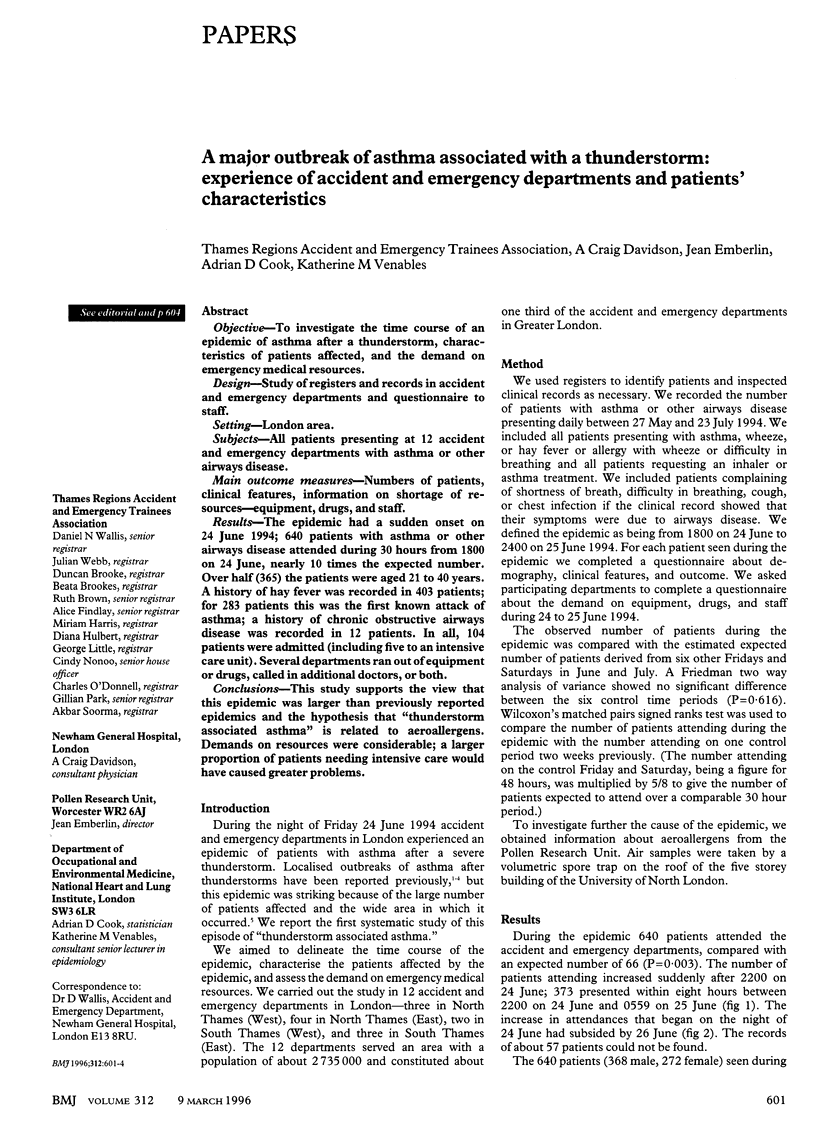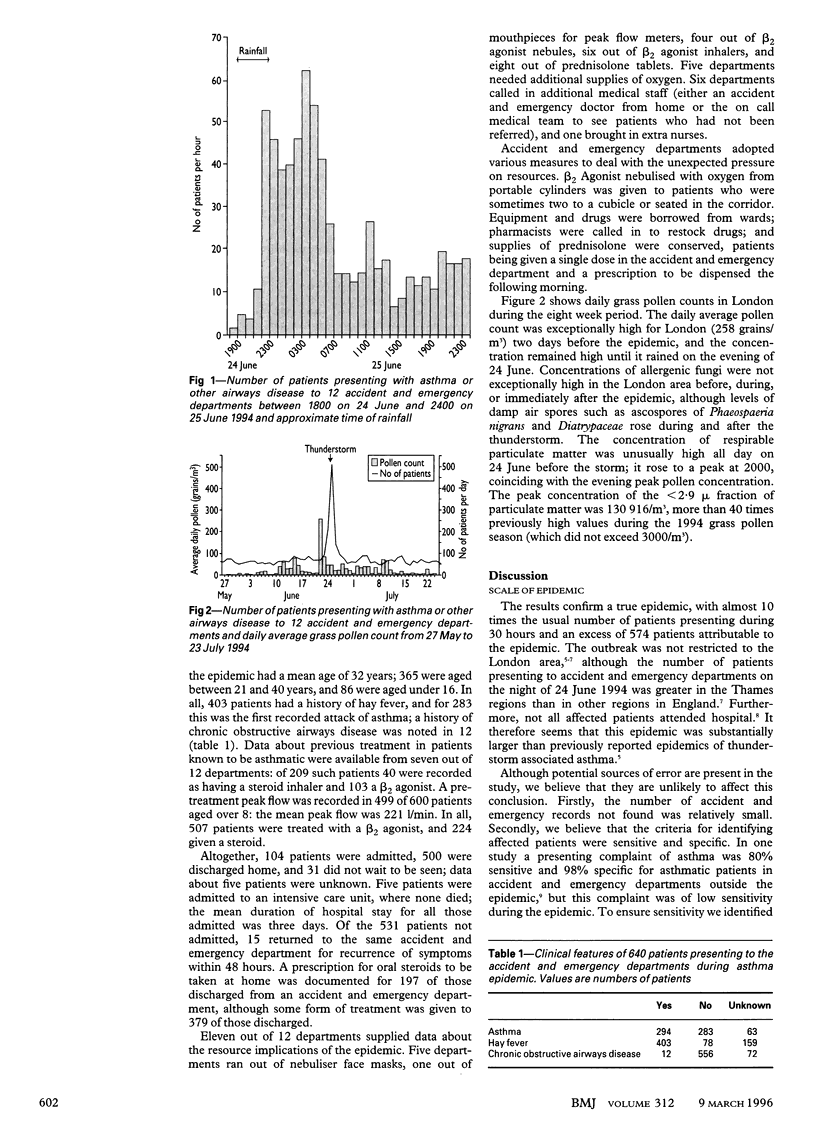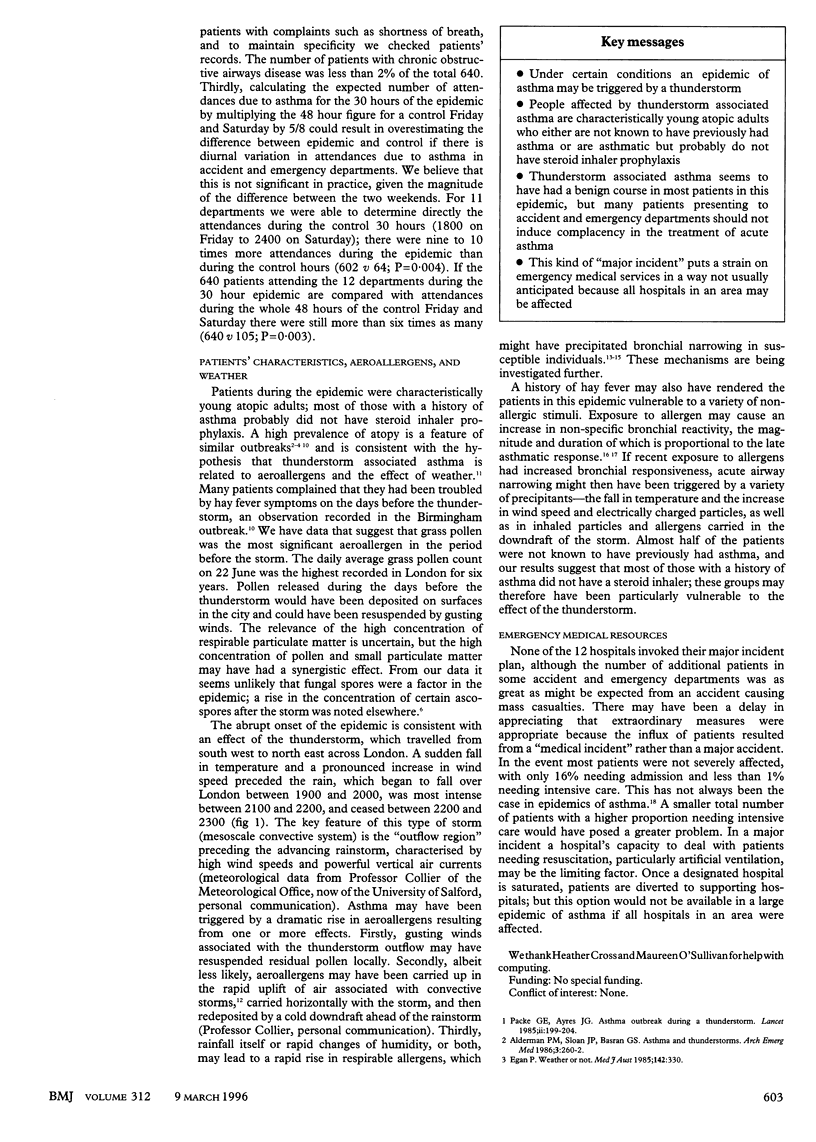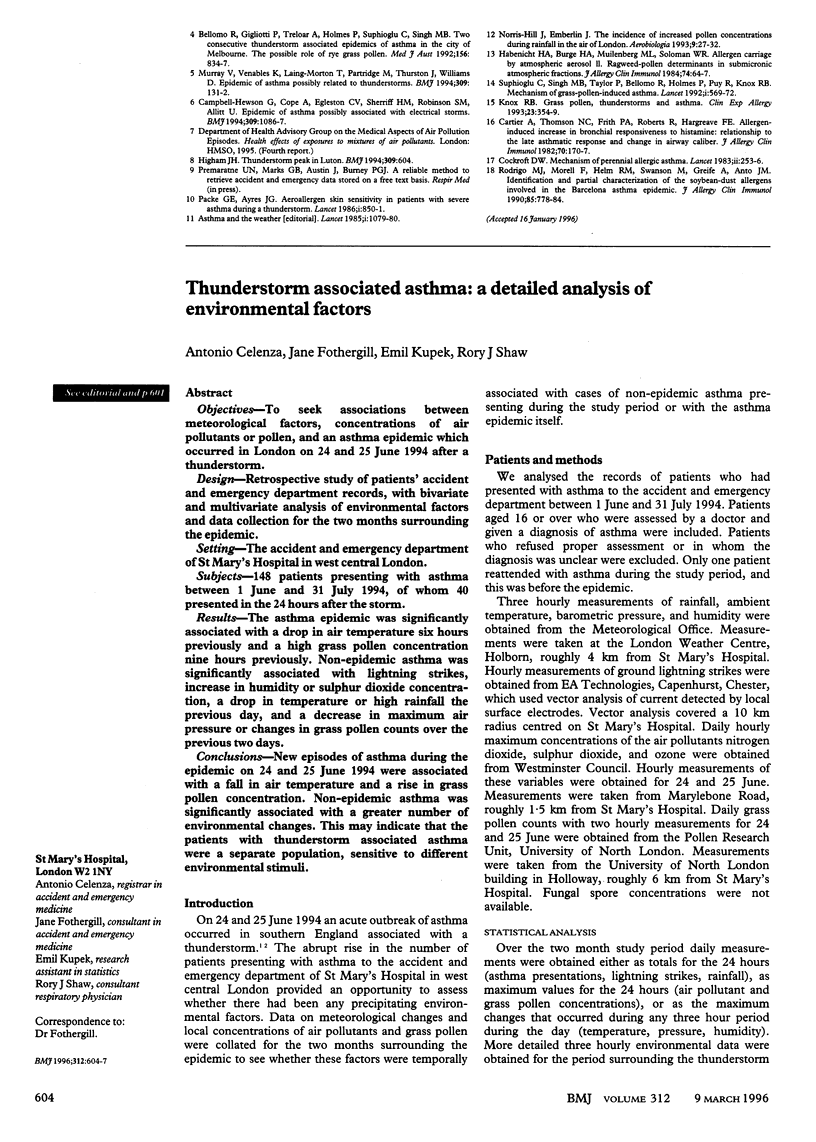Abstract
OBJECTIVE--To investigate the time course of an epidemic of asthma after a thunderstorm, characteristics of patients affected, and the demand on emergency medical resources. DESIGN--Study of registers and records in accident and emergency departments and questionnaire to staff. SETTING--London area. SUBJECTS--All patients presenting at 12 accident and emergency departments with asthma or other airway disease. MAIN OUTCOME MEASURES--Numbers of patients, clinical features, information on shortage of resources--equipment, drugs and staff. RESULTS--The epidemic had a sudden onset on 24 June 1994; 640 patients with asthma or other airways disease attended during 30 hours from 1800 on 24 June, nearly 10 times the expected number. Over half (365) the patients were aged 21 to 40 years. A history of hay fever was recorded in 403 patients; for 283 patients this was the first known attack of asthma; a history of chronic obstructive airways disease was recorded in 12 patients. In all, 104 patients were admitted (including five to an intensive care unit). Several departments ran out of equipment or drugs, called in additional doctors, or both. CONCLUSIONS--This study supports the view that this epidemic was larger than previously reported epidemics and the hypothesis that "thunderstorm associated asthma' is related to aeroallergens. Demands on resources were considerable; a larger proportion of patients needing intensive care would have caused greater problems.
Full text
PDF



Selected References
These references are in PubMed. This may not be the complete list of references from this article.
- Alderman P. M., Sloan J. P., Basran G. S. Asthma and thunderstorms. Arch Emerg Med. 1986 Dec;3(4):260–262. doi: 10.1136/emj.3.4.260. [DOI] [PMC free article] [PubMed] [Google Scholar]
- Bellomo R., Gigliotti P., Treloar A., Holmes P., Suphioglu C., Singh M. B., Knox B. Two consecutive thunderstorm associated epidemics of asthma in the city of Melbourne. The possible role of rye grass pollen. Med J Aust. 1992 Jun 15;156(12):834–837. doi: 10.5694/j.1326-5377.1992.tb136994.x. [DOI] [PubMed] [Google Scholar]
- Campbell-Hewson G., Cope A., Egleston C. V., Sherriff H. M., Robinson S. M., Allitt U. Epidemic of asthma possibly associated with electrical storms. BMJ. 1994 Oct 22;309(6961):1086–1087. doi: 10.1136/bmj.309.6961.1086a. [DOI] [PMC free article] [PubMed] [Google Scholar]
- Cartier A., Thomson N. C., Frith P. A., Roberts R., Hargreave F. E. Allergen-induced increase in bronchial responsiveness to histamine: relationship to the late asthmatic response and change in airway caliber. J Allergy Clin Immunol. 1982 Sep;70(3):170–177. doi: 10.1016/0091-6749(82)90038-0. [DOI] [PubMed] [Google Scholar]
- Cockcroft D. W. Mechanism of perennial allergic asthma. Lancet. 1983 Jul 30;2(8344):253–256. doi: 10.1016/s0140-6736(83)90235-0. [DOI] [PubMed] [Google Scholar]
- Egan P. Weather or not. Med J Aust. 1985 Mar 4;142(5):330–330. doi: 10.5694/j.1326-5377.1985.tb113389.x. [DOI] [PubMed] [Google Scholar]
- Habenicht H. A., Burge H. A., Muilenberg M. L., Solomon W. R. Allergen carriage by atmospheric aerosol. II. Ragweed-pollen determinants in submicronic atmospheric fractions. J Allergy Clin Immunol. 1984 Jul;74(1):64–67. doi: 10.1016/0091-6749(84)90088-5. [DOI] [PubMed] [Google Scholar]
- Higham J. H. Asthma trends. Thunderstorm peak in Luton. BMJ. 1994 Sep 3;309(6954):604–604. [PMC free article] [PubMed] [Google Scholar]
- Knox R. B. Grass pollen, thunderstorms and asthma. Clin Exp Allergy. 1993 May;23(5):354–359. doi: 10.1111/j.1365-2222.1993.tb00339.x. [DOI] [PubMed] [Google Scholar]
- Murray V., Venables K., Laing-Morton T., Partridge M., Thurston J., Williams D. Epidemic of asthma possibly related to thunderstorms. BMJ. 1994 Jul 9;309(6947):131–132. doi: 10.1136/bmj.309.6947.131c. [DOI] [PMC free article] [PubMed] [Google Scholar]
- Packe G. E., Ayres J. G. Aeroallergen skin sensitivity in patients with severe asthma during a thunderstorm. Lancet. 1986 Apr 12;1(8485):850–851. doi: 10.1016/s0140-6736(86)90954-2. [DOI] [PubMed] [Google Scholar]
- Rodrigo M. J., Morell F., Helm R. M., Swanson M., Greife A., Anto J. M., Sunyer J., Reed C. E. Identification and partial characterization of the soybean-dust allergens involved in the Barcelona asthma epidemic. J Allergy Clin Immunol. 1990 Apr;85(4):778–784. doi: 10.1016/0091-6749(90)90198-d. [DOI] [PubMed] [Google Scholar]
- Suphioglu C., Singh M. B., Taylor P., Bellomo R., Holmes P., Puy R., Knox R. B. Mechanism of grass-pollen-induced asthma. Lancet. 1992 Mar 7;339(8793):569–572. doi: 10.1016/0140-6736(92)90864-y. [DOI] [PubMed] [Google Scholar]


